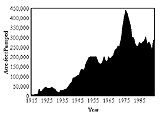
| ch. 2, pp. 9 - 10 |
Growth and Controversy After World War II the pace of population growth quickened, and by the 1950s, the southside and northside wells could no longer produce enough water. The Arizona Daily Star headline read “More Water is Urgently Needed.” (July 23, 1952) “Living in desert country, where a rainbucket on the roof wouldn’t provide more than a good shampoo, it is natural to wonder if the city can furnish sufficient water to meet this modern expansion. The answer is a big YES, according to Water Superintendent Phil J. Martin, Jr., if the proposed $5,500,000 water revenue bond issue is given the nod by voters Aug. 12.” The big bond issue passed, and a series of wells was drilled between 1954 and 1968 along Old Nogales Highway, south of Valencia Road on the edge of the San Xavier District. Some private wells in the area also were purchased, for a total of 34 wells, 15 of which are still active today. The area is called the Santa Cruz Wellfield. This additional pumping contributed to further lowering of the area’s water table,, causing the extensive mesquite bosque south of San Xavier Mission to die in the 1950s. Water problems at San Xavier intensified. By the 1960s, population had increased to the extent that even these three established wellfields did not provide enough water. The city began to purchase farms in the Avra Valley to the west to gain access to their wells. The plan was to bring the water to the city through a large pipeline. During its period of peak operation, 27 wells were operating in the Avra Valley area, 20 of which are still active. The city also purchased land along the San Pedro River north of Benson to obtain water rights. The plan called for construction of a pipeline over the mountain pass to bring San Pedro River water to Tucson. This pipeline was never built, and the city ultimately sold the land. During this time, the city also was buying water companies and their wells throughout the city limits. When a new area was annexed, the city would offer to buy the water company. Having all the water service under city control had the advantage of providing uniform water service and assuring adequate pressure for fire fighting (See Figure 2-6). Some areas such as Flowing Wells and Winterhaven never came under city control. The collection of almost 300 city-owned wells in the central city area is referred to as the Central Wellfield, although it is not a coherent system, but rather a collection of former private systems and some city-drilled wells. In 1998, 185 wells were active in this area Starting in the 1960s the city adopted a policy of buying water companies outside city limits. The city also extended its water service outside city limits in areas not served by other companies. The purpose of this strategy was to enable the city to engage in basinwide management of water supplies. This would promote more equitable water service and allow sharing of costs to augment the supply. This patchwork of water systems often caused problems. Water mains had to be connected to the central system in most cases, and the quality and size of the wells and pipelines varied greatly. Serving water outside city limits also meant that many customers would have no vote on water matters and no representation on the City Council that decided water issues. The 1970s were a period of turmoil for the community. Advocates of “controlled growth” gained a majority on the City Council and also were a significant presence on the Pima County Board of Supervisors and in the Pima County delegation to the Legislature. Congress had approved the CAP, and Tucson had to decide whether to contract for CAP water. The controlled growth advocates were skeptical about CAP, questioning its cost, need, long-term reliability and the quality of the water. They also argued that controlling sprawl was an appropriate strategy to discourage a rapid increase in the cost of water. They supported much stronger water conservation efforts and less agricultural use of water. Controlled growth advocates on the Tucson City Council soon found an opportunity to press for change by dealing with the pressures facing the Tucson Water Department. The distribution system was expanded rapidly in the early 1970s to keep up with growth. Revenues from relatively low water rates were not enough to keep up with increasing costs and there was not enough system capacity to meet peak demand during hot summers, such as the summer of 1974. To address the problem, a consultant’s report recommended a six-year program of improvements to the distribution system, to be financed by bond sales, higher water rates and system development charges. Water rates would be designed to recover the actual costs of providing service, including a “lift charge” for providing water to customers at higher elevations, such as those in the foothills. System development charges would be applied to new customers to help pay for expansion of the system. In 1976, the City Council voted for a water rate increase designed both to keep up with inflation and to recover actual costs of delivery. The new rates included the lift charge and retained the progressive rate structure (i.e., people who use water above certain amounts were charged higher rates for water consumed above that amount) which was first used in Tucson Water’s rate structure in 1974. The new rates were adopted in June, and water bills of some customers in the high lift zones quadrupled from June to July, while bills of many others doubled.
The pro-CAP and pro-growth forces encouraged an angry public to revolt, and the City Council majority was recalled even though they rescinded the lift charge in August. After discovering that rates had been raised not to control growth, as had been assumed, but to build distribution systems and gain new water supplies to meet expected growth, their successors retained the rest of the new rate structure and even raised the rates again. The impact of the recall continues to this day, with City Council members and water staff reluctant to make major changes to water rates in fear of angering water customers. “Remember the recall” remains a formidable slogan.
|

